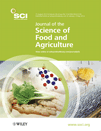
JOURNAL OF THE SCIENCE OF FOOD AND AGRICULTURE
Scope & Guideline
Shaping the future of food through rigorous research.
Introduction
Aims and Scopes
- Food Quality and Safety:
Research on the preservation, safety, and quality of food products, including studies on microbial contamination, antioxidant properties, and the effects of processing methods. - Nutritional and Functional Properties:
Exploration of the nutritional composition of various food sources, including the bioavailability of essential nutrients and the impact of dietary components on health outcomes. - Innovative Food Processing Techniques:
Development and evaluation of novel food processing methods, such as ultrasound-assisted extraction, high-pressure processing, and fermentation technologies to improve food quality and safety. - Environmental Sustainability in Agriculture:
Studies focusing on sustainable agricultural practices, including the use of biostimulants, crop management strategies, and the impact of climate change on crop yield and quality. - Biotechnology Applications in Food and Agriculture:
Research utilizing biotechnological approaches to enhance food production, quality, and safety, including genetic modification, fermentation, and the use of probiotics. - Food Waste Valorization:
Innovative methods for converting food waste into valuable products, emphasizing sustainability and resource efficiency.
Trending and Emerging
- Plant-Based Proteins and Alternatives:
An increasing focus on the development and utilization of plant-based proteins and alternative ingredients in food products, catering to the growing demand for vegetarian and vegan options. - Functional Foods and Nutraceuticals:
A trend towards investigating foods with added health benefits, including probiotics, prebiotics, and bioactive compounds that contribute to health promotion. - Sustainable Agriculture Practices:
Research on sustainable farming practices is gaining momentum, emphasizing climate-resilient techniques, soil health improvement, and resource use efficiency. - Food Waste Reduction and Valorization:
A growing interest in innovative strategies for reducing food waste and converting by-products into value-added products is emerging. - Smart Agriculture Technologies:
The integration of digital technologies such as machine learning, remote sensing, and data analytics in agriculture to enhance productivity and sustainability is becoming increasingly prevalent. - Microbiome Research in Food Systems:
Emerging research on the role of microbiomes in food production, safety, and health, including the impact of gut microbiota on metabolic processes and health outcomes.
Declining or Waning
- Traditional Food Preservation Methods:
Research on conventional preservation techniques such as canning and salting has decreased, as newer technologies like high-pressure processing gain traction. - Chemical Additives in Food Processing:
The focus on chemical preservatives and additives appears to be waning, with a greater emphasis on natural alternatives and clean label products. - Single Crop Studies:
There is a noticeable decline in research solely focused on single crop studies, with a shift towards integrated approaches that consider intercropping and polyculture systems. - Animal-Based Food Processing:
Interest in research focused exclusively on traditional animal-based food processing methods is declining, potentially due to the rising popularity of plant-based alternatives. - Conventional Fertilizer Use:
Research emphasizing conventional fertilizers is decreasing as the field shifts towards organic and sustainable fertilization techniques.
Similar Journals
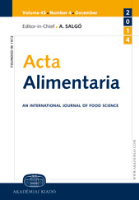
ACTA ALIMENTARIA
Advancing food science through rigorous research.ACTA ALIMENTARIA is a renowned journal in the field of food science, published by AKADEMIAI KIADO ZRT, based in Hungary. Since its inception in 1973, it has served as a vital platform for disseminating high-quality research on food chemistry, microbiology, nutrition, and technology, contributing significantly to the advancement of knowledge in the agricultural and biological sciences. Currently classified in the Q3 quartile of the 2023 Food Science category, the journal is positioned to address pressing issues pertaining to food safety, quality, and sustainability, making it an invaluable resource for researchers, professionals, and students alike. Although it does not currently offer open access, the journal maintains a strong reputation with a readership keenly interested in the latest developments in food science. With a Scopus rank placing it in the 38th percentile of its category, ACTA ALIMENTARIA continues to be a pivotal reference for those engaged in food research and innovation.

Food Chemistry-X
Unlocking Innovations in Food Chemistry.Food Chemistry-X is a premier open-access journal published by Elsevier, dedicated to advancing the field of food chemistry through high-quality research and comprehensive reviews. With its ISSN of 2590-1575, the journal has gained significant attention since adopting an open-access model in 2019, allowing wide dissemination of knowledge and innovations in food science. Based in the United Kingdom, it holds prestigious Q1 rankings in both Analytical Chemistry and Food Science categories as of 2023, positioning itself as a leading platform for researchers worldwide. The journal's focus spans extensive topics within food chemistry, including food safety, nutritional analysis, and the chemical properties of food, offering insights that are crucial for addressing contemporary challenges in food production and consumption. With a Scopus rank placing it in the 65th percentile among the top journals in Food Science and the 58th percentile in Analytical Chemistry, Food Chemistry-X is an essential resource for academics, professionals, and students seeking to stay at the forefront of research and innovation in this vibrant field.
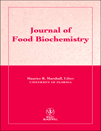
JOURNAL OF FOOD BIOCHEMISTRY
Contributing to the Future of Food Safety and QualityJOURNAL OF FOOD BIOCHEMISTRY, published by Wiley-Hindawi in the United Kingdom, is a premier peer-reviewed journal dedicated to advancing the scientific understanding of food biochemistry. With an extensive publication history spanning from 1977 to 2024, this journal aims to bridge the gap between food science and biochemistry, making significant contributions to the understanding of food structure and composition. The journal boasts impressive Scopus rankings, placing it within the top quartile in Food Science and Q2 in Biophysics and Pharmacology, affirming its influence in the field. Notably, it provides critical insights that are vital for researchers, professionals, and students aiming to explore the biochemical processes involved in food production and safety. Despite not being open access, the journal ensures wide distribution of high-quality research, fostering collaboration and innovation within the scientific community. The impact factor reflects its relevance and quality, further solidifying its status as a key resource for cutting-edge research in food biochemistry.
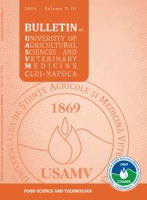
Bulletin of University of Agricultural Sciences and Veterinary Medicine Cluj-Napoca-Food Science and Technology
Elevating Research in Agricultural Sciences and Food InnovationBulletin of University of Agricultural Sciences and Veterinary Medicine Cluj-Napoca - Food Science and Technology is a prominent peer-reviewed journal dedicated to advancing the field of food science and technology. Published by the University of Agricultural Sciences and Veterinary Medicine Cluj-Napoca, this open-access journal has been serving the academic community since 2013, promoting the dissemination of high-quality research that addresses pressing issues in food safety, quality, and innovation. With its ISSN 2344-2344 and E-ISSN 2344-5300, the journal aims to bridge the gap between academia and industry by providing a platform for scholars and practitioners to share their findings, insights, and methodologies. Situated in the heart of Romania, the journal reflects the country's rich agricultural heritage and its commitment to enhancing global food systems. By maintaining a rigorous editorial standard, the Bulletin ensures that it remains a vital resource for researchers, industry professionals, and students who are keen to explore the latest developments in food science.

Applied Food Research
Unleashing the Potential of Food ResearchApplied Food Research, published by Elsevier, is an esteemed journal that plays a critical role in advancing the field of Food Science. With an ISSN of 2772-5022, the journal has established itself as a premier outlet for high-quality research, achieving a commendable Q1 ranking in the 2023 Food Science category and a 63rd percentile in Scopus rankings for Agricultural and Biological Sciences. Covering a diverse range of topics from food safety to innovative processing techniques, Applied Food Research seeks to publish pioneering studies that enhance our understanding of food systems and contribute to broader discussions on sustainability and nutrition. As it converges on its fourth year of publication, researchers, professionals, and students alike are encouraged to engage with its content through various open access options, ensuring widespread dissemination of knowledge in a field that is vital to global health and well-being. Operating out of Amsterdam, Netherlands, this journal is poised to be an indispensable resource for anyone dedicated to making significant contributions in the domain of food science.
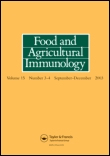
FOOD AND AGRICULTURAL IMMUNOLOGY
Connecting Immunology and Agriculture for a Sustainable FutureFOOD AND AGRICULTURAL IMMUNOLOGY, published by Taylor & Francis Ltd, is a distinguished journal dedicated to the intersection of immunology and agricultural sciences, providing valuable insights in areas such as food safety, plant health, and disease resistance since its inception in 1989. Operating as an Open Access journal since 2017, it offers researchers and professionals unrestricted access to groundbreaking studies and reviews that advance the understanding of immunological responses in agricultural contexts. With its current quartile rankings of Q2 in Agronomy and Crop Science and Q3 in Food Science, as well as Q4 in Immunology, the journal has established itself as a vital resource for those aiming to enhance the quality and safety of food production through innovative research. By leveraging its impressive Scopus rankings across various categories, the journal promotes interdisciplinary collaboration and knowledge dissemination pertinent to both scientists and policymakers engaged in the agricultural and food sectors.

COMPREHENSIVE REVIEWS IN FOOD SCIENCE AND FOOD SAFETY
Elevating Food Science Through Rigorous ReviewsCOMPREHENSIVE REVIEWS IN FOOD SCIENCE AND FOOD SAFETY, published by Wiley, is a premier journal dedicated to advancing the understanding of food science and safety through thorough and critical reviews. With an impressive Q1 ranking in the field of Food Science and a notable Scopus ranking of #4 out of 389 in Agricultural and Biological Sciences, this journal occupies a vital position within the academic community. Its rigorous approach to publishing comprehensive reviews serves as an invaluable resource for researchers, professionals, and students aiming to stay abreast of current trends and advancements in the food sector. Although the journal does not offer open access options, its contributions from 2002 through 2024 reflect a commitment to high-quality scholarship and knowledge dissemination. Researchers looking to elevate their understanding of food safety and related disciplines will find this journal an essential addition to their academic repertoire.

JOURNAL OF FOOD SCIENCE AND TECHNOLOGY-MYSORE
Nurturing the Evolution of Food Science and TechnologyJOURNAL OF FOOD SCIENCE AND TECHNOLOGY-MYSORE, published by SPRINGER INDIA, is a distinguished peer-reviewed journal that has been contributing to the ever-evolving field of food science since its inception in 1974. With an ISSN of 0022-1155 and E-ISSN 0975-8402, this journal holds a commendable position in the Q2 category for Food Science, as per the 2023 metrics, and ranks #58 out of 389 in Scopus's Agricultural and Biological Sciences sector, achieving an impressive 85th percentile. The journal publishes high-quality research articles, reviews, and case studies that cover a wide array of topics, from food preservation to innovative technologies in food processing. Although it is not an open-access journal, it endeavors to disseminate essential knowledge and research strategies that advance food science and benefit both industry professionals and academia. The geographical reach of the journal, alongside its rigorous editorial standards, solidifies its stature as a pivotal resource for researchers, professionals, and students dedicated to the enhancement of food science practices and technologies.
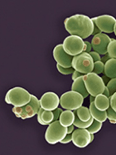
Annual Review of Food Science and Technology
Elevating Knowledge in Food Science and TechnologyThe Annual Review of Food Science and Technology, published by ANNUAL REVIEWS, is an esteemed journal dedicated to advancing the knowledge within the field of food science. With an impressive Q1 ranking in the Food Science category, and ranking as #6 out of 389 in the Scopus Agricultural and Biological Sciences category, the journal serves as a vital resource for researchers, professionals, and students. This publication encapsulates comprehensive reviews and cutting-edge research, helping to bridge the gap between research and practical application. Though it does not offer Open Access, it provides valuable insights into various aspects of food science from 2010 to 2024, ensuring that its readership stays at the forefront of emerging trends and innovations. The journal's focus on high-quality, peer-reviewed articles makes it a critical platform for scholars looking to deepen their understanding and contribute to this rapidly evolving field.

JOURNAL OF THE JAPANESE SOCIETY FOR FOOD SCIENCE AND TECHNOLOGY-NIPPON SHOKUHIN KAGAKU KOGAKU KAISHI
Innovating Together: Bridging Food Science and TechnologyWelcome to the JOURNAL OF THE JAPANESE SOCIETY FOR FOOD SCIENCE AND TECHNOLOGY-NIPPON SHOKUHIN KAGAKU KOGAKU KAISHI, a pivotal platform for the advancement of food science and technology. Published by the Japan Society for Food Science and Technology, this esteemed journal has been contributing to the field since 1995 and continues to publish innovative research and reviews that foster knowledge and collaboration among researchers, professionals, and students interested in food science. Although it currently holds a Q4 ranking within the Food Science category, the journal's commitment to disseminating valuable insights showcases its potential as a resource for emerging trends and applications in food technology. While it does not offer open access options, it maintains a rigorous peer-review process to ensure the quality of its content. As this journal progresses into its convergence years through 2024, it remains an essential resource for those passionate about exploring the intersections of food science and technology in Japan and beyond.